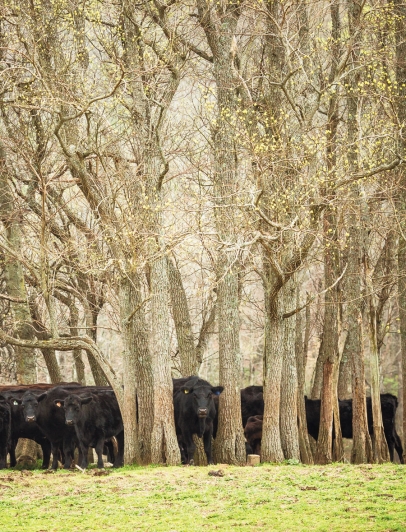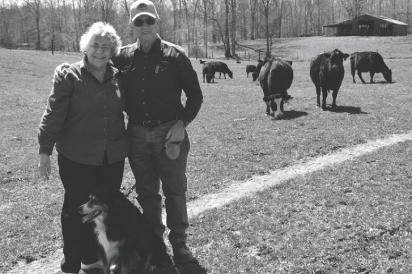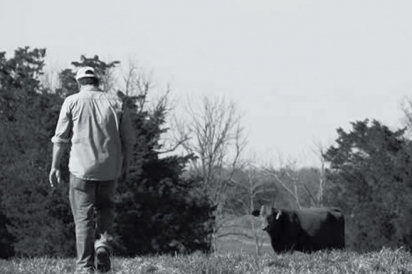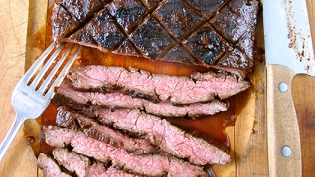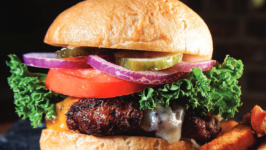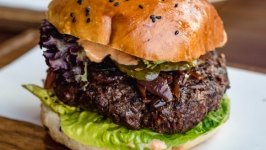Splendor in the Grass: Local grass-fed beef is big business
Grass-fed beef is all the rage. Find out why.
Perhaps the first mistake cattle rancher Kenneth Drinnon made was the practice of naming his calves. One of his first cows, named M.C. after a friend, lived to the ripe old cow age of 20.
When she was euthanized only a couple years ago, Kenneth says, “I cried like a baby.” He cares deeply about each of his animals, but he assured me he wouldn’t be keeping any more as pets. Kenneth and his wife Lucy were seeking a peaceful retirement project when they moved from Los Angeles to their 84-acre farm, just outside of Ashland City, TN, in 1993.
“It started out as something for us to meddle with,” explains Kenneth. The farm’s previous owner had a few cows, but the property was “pretty run down” when the Drinnons bought it. Kenneth’s childhood on a dairy and tobacco farm in East Tennessee was the only background the couple had in farming, but they were able to grow the “project” into a profitable beef business in only a few years.
Seventy-five percent of KLD’s sales is to 11 Nashville restaurants, with the rest going to a loyal handful of local individuals and families. The cattle at KLD farm are “grass-fed, grain-finished,” which means that they’re raised on grass pastures but eat grain in the final months before slaughter. The grain introduces fat, known in the industry as “marbling,” to the meat — a taste and texture some consumers and most chefs prefer.
Kenneth and Lucy agree their favorite aspect of owning and operating a beef farm is living in the quiet countryside while providing a product in which they take pride. “I just like the lifestyle,” Lucy says. “You meet so many nice people.”
“Having the land, the space,” Kenneth says, “And not having to listen to someone else’s boom boom box.”
“STARTS WITH THE SOIL”
While the Drinnons became beef farmers after retirement, nearby Tennessee beef farmer Steve Robertson started working on his family’s grass-fed beef farm at the ripe age of eight.
“I got paid $3 for cutting the yard. I saved up my money, and I bought a lot of calves right away. I always liked the farm and livestock, cattle especially … When I bought my first calf, I was probably 10 or so,” he says. “I bought one big enough to eat grass.” Robertson paid $57 for his first calf — an animal that would cost $800 today. He has raised cows for beef ever since, with an added emphasis on raising the cows entirely on grass. However, he found out the hard way that certain grasses make for tastier meat. After his wife complained about the taste of the beef, Steve spent a couple of years researching grasses.
“Tennessee is in the ‘fescue belt,’ and fescue (specifically Kentucky 31) doesn’t make for good tasting meat,” he says. Because the grass that cattle eat during the last three months of life (what they’re “finished” on) is the key factor in the meat’s flavor, Steve finishes his cattle on a secret combination of grasses that he won’t divulge, which results in well marbled beef. Now his beef is “wife approved” —and apparently Middle Tennessee approved, too: his business has doubled in the past year, just by word-of-mouth.
Robertson says he is particularly proud of the health of the soil in the pasture where his cows are finished, the last pasture they live in. “I’m planning to get the rest of the fields that way,” he promises.
ALL IN GOOD TASTE
Adam Deal, who owns and operates Nashville Cattle Co. with his sister Courtney in Shelbyville, TN, raises his cows from a cook’s perspective. In 2013, Deal sold his hotdog/ burger shop, The Dog of Nashville, to focus on the grass-fed beef operation that he and Courtney founded as an offshoot of their family’s decades-old cattle ranch.
“Cooking is important to me,” the Nashville native says. “Grass-fed beef is seasonal, which a lot of people don’t talk about. There’s certain times of year when grass-fed beef tastes better than others because of what they’re eating. If you just pluck a cow out of a field in winter when it’s eating hay and other winter grasses, it’s going to take on a gamey flavor. We find that spring and early summer is the best time and best flavor for grass-fed beef— when, on our farm, they’re eating a lot of ryegrass and clover.”
Like the Drinnons, Deal finishes his cows with grain to produce well-marbled, flavorful beef. In general, grass-fed beef tends to be leaner than beef from cows that are fed corn. Deal’s biggest challenge today is educating his customers on how to cook grass-fed beef—because many don’t realize it requires different techniques.
“Grain-fed beef has more fat. It’s more tender, easier to cook,” Deal says. “It’s what people are used to. As a meat salesman, it’s sometimes a little daunting to take a steak to someone who may screw it up and then blame you for why it’s so dry.” But despite the challenges in producing and selling grass-fed beef, Deal says he wouldn’t do it any other way. He is proud that he is raising his cattle in open pastures “as they would live otherwise.”
“We just believe in the natural philosophy,” he says. “In the wild a cow would just eat grass. No antibiotics, no unneeded medicine, freedom to graze… that’s just our philosophy.”
Green with Envy
COST: Grass-fed beef costs more than conventional beef because grass-fed cattle require more land (for pasture), more water (for irrigation), and more time (since grain-fed cattle fatten faster).
ANIMAL WELFARE: Because grass-fed cattle graze on pastures, we can only assume that they are happier.
ENVIRONMENT: Well-managed pastures preserve soil quality, prevent erosion, and reduce wasteful runoff of water. When grass-fed beef farms are managed well, resources cycle through a more closed circle—keeping the land and atmosphere healthier on a small scale.
SUPPORTING LOCAL: Buying from local grass-fed farms keeps money in the local economy and supports the “underdogs” who are competing against giant corporations.
NUTRITION: Grass-fed cattle are less susceptible to infections, so they’re less likely to be fed antibiotics. Grass-fed beef is leaner and higher in omega-3 fats than traditional grain-fed beef.
OUR GRASS-FED CITY
West Wind Farms
CSA Pickup Franklin Farmers’ Market, West Nashville, Green Hills, South Nashville, East Nashville & Bellevue
Gourmet Pasture Beef
Delivery available
Tennessee Grass-Fed Farm
Green Door Gourmet Hendersonville Produce Nashville Farmers’ Market Franklin Farmers’ Market Porter Road Butcher
Tennessee Grass Fed Farm
CSA Pickup at Nashville Farmers’ Market and many other locations
Peaceful Pastures
Hip Donelson Farmers’ Market Franklin Farmers’ Market
Walnut Hills Farms
Nashville Farmers’ Market, Vanderbilt Farmers’ Market, The Church at Indian Lake, Hendersonville
Rocky Glade Farm
Franklin Farmers’ Market Fresh Harvest Cooperative
Beaverdam Creek Farm
Franklin Farmers’ Market Herban Market, Franklin 12 South Farmers’ Market White’s Mercantile
Triple L Ranch
Delivery available Franklin Farmers’ Market
KLD Farm
Nashville Farmers’ Market Porter Road Butcher
Bear Creek Farms
Franklin Farmers’ Market


